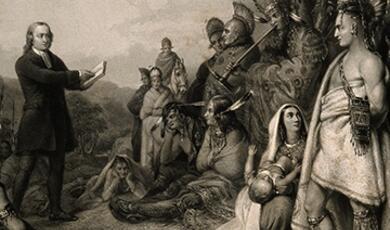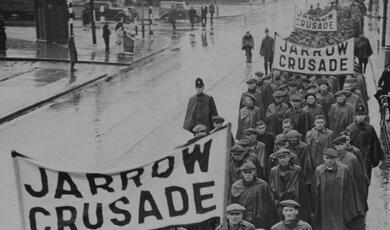Why Did Europe’s Economies Diverge from Asia?
Share
- Details
- Text
- Audio
- Downloads
- Extra Reading
The levels of income in parts of China and India were similar to those in Europe in the middle ages, until the Mediterranean pulled ahead – followed by northern Europe, initially Holland and then Britain. This ‘great divergence’ was one of the fundamental shifts in history – and is only now being reversed.
Did the divergence arise from imperialism and a 'drain' of wealth from Asia, or did it arise from internal features of Asian and European Society?
Download Text
Why Did Europe’s Economies Diverge from Asia?
Professor Martin Daunton
8th November 2022
Over the last few decades, there has been a transformation of world historical significance: China’s rise to be the world’s second largest economy has both pulled millions out of poverty and led to threats of trade war and geopolitical disruption. China still has some way to go before it closes the gap in per capita incomes with the United States – and India has still further to go. But the gap is narrowing. Data from the World Inequality Database shows that GDP per adult was 13.5 times that of China in 1960 – by 2020 it was down to 3.1 times.
This convergence follows from an earlier ‘Great Divergence’. What we are now seeing is a return to an earlier pattern when Asian economies were as successful as Europe, with equivalent levels of per capita income. The historical question I wish to explore today is – to take the title of a recent book by Prasannan Parthasarthi - ‘Why Europe Grew Rich and Asia Did Not’.
Let’s go back in time to the eighteenth century and across the globe to two places which were both economically successful and prosperous, supplying highly valued commodities to European markets. We need to rewrite the history of globalisation - not as a process centred on Europe but with equal weight to China and India – and then to put the British industrial revolution in this global context.
Jingdezhen in China – the city of blue and white porcelain
Premier site of ceramics production in the world from 11th to early 18th centuries
Reached global markets in Japan, Korea, middle east, and Europe. Chinese policy veered from encouragement to prohibition of Chinese merchants in overseas trade, but they continued to trade. From 16th century, Europeans entered the market – at first the Portuguese and then from the start of the 17th century, the Dutch and English East India Companies.
How did Jingdezhen achieve this global position?
It was not alone: in competition with other centres in China and Asia – knowledge of consumer preferences.
Embedded in global networks, for example for cobalt, much of which came from Persia.
Role of the imperial court: not just the emperor and family. For example, 100,000 eunuchs, each with servants and perhaps an adopted son. In 1433, Jingdezhen required to send 443,500 pieces of porcelain.
Tension between the administrators and workers in the kilns – the administrators tried to control flow of resources, reserve fine local clay for the imperial household; try to bind skilled workers to the imperial and not private kilns.
The products from these kilns were exported in huge quantities to Europe – and led to cheaper imitation – what is called “populuxe”, for example by Delft. Such emulation was an important feature of European industrialisation.
By later 18th century, European production was able to compete – Wedgwood, Meissen, Sevres. When Lod Macartney visited China in 1793, he took British porcelain with him, confident of its superiority.
Indian textiles
Until 1800, India was the world’s major centre for the production of cotton textiles – and as with porcelain, not just for the local market. Cloth was traded across the Indian Ocean world; found in Egypt, Iran from 11th century.
Production was concentrated in three areas:
- Gujarat on west coast: supplied the Indian Ocean trading world; painted cloths and muslins
- Coromandel on east coast: supplied south-east Asia, known for its printed textiles which could imitate European silk designs; and in the 18th century for blue cloth dyed with indigo that were sold mainly in West Africa.
- Bengal increasingly important from early 17th century, a frontier region that became settled, with growing towns and rice cultivation: fine muslins and cotton/silk mix – not printed or painted, but finely woven and finished; some embroidered.
- Other centres inland – Delhi, Punjab more for local markets
Trade reached a large scale by the 15th century, and production boomed from the mid-16th century with demand in Ottoman empire, Iran and Atlantic world (from West Africa to Europe and Americas). From the middle of the 17th century, European demand grew – the English and Dutch East India companies took 20 per cent of output from south India 1700-25. In particular, there was an expansion from Bengal in the export of plain white cloth (calicoes) for printing in Europe.
Both of these areas were centres of global trade networks. What we see is a global economy that was not centred on Europe, but what Ken Pomeranz calls ‘a polycentric world with no dominant centre… Only after nineteenth-century industrialization was well advanced does it make sense to see a single, hegemonic European “core”’.’
Huge demand in Europe for goods from China and India with little trade going the other way, so it was paid for in bullion. India took about 20 per cent of global silver production from 1600 to 1800, contributed to economic expansion in India. Silver in India created liquidity and led to a commercial boom.
This success of Asian goods in European markets led to two concerns:
-
- Loss of bullion was seen as a threat to prosperity and state power:
- Also, a concern over employment: Indian textiles would undermine European woollen, silk and linen industries which would lead to unemployment and disorder (at least, that was the claim of the industry to justify state intervention).
Then at some point, the west pulled ahead – the Great Divergence. Historians agree it happened – not about when or why. These are very much open questions that are at the frontier of historical research.
When Did the Divergence Happen?
In 2000, Ken Pomenanz in The Great Divergence, the book that started the debate, put the divergence around 1800. In his view, Europe ‘did not in fact become much better -off than east Asia until industrialization was well under way’. He argues that Europe was not free of Malthusian pressures any more than other large economies before 1800: it could, like Asia, have gone down a labour-intensive, resource-saving route rather than – as it did – a labour-saving resource-intensive route.
His claim led others to attempt the impossible: to measure GDP per capita between different parts of the world over the very long term. You might think, as I do, that the attempt borders on the absurd – we do not have secure data on the size of the population, let alone the level of economic activity. These figures come with serious health warnings – but they are shaping the debate.
Stephen Broadberry of Oxford University and colleagues argue the divergence was much earlier: the Mediterranean drew ahead by no later than 1300, and then Holland in the 15th century; and strikingly England from the mid-17th century – the ‘little divergence’ within Europe.
The data are suspect – and so are the comparisons. Comparing the most prosperous small parts of Europe and the whole of China is meaningless. Broadberry himself admits that the richest parts of China – the Yangzi delta on a wide definition had a population of 31 to 37 million in 1750 when England was only around 6m and Britain under 8m. The Yangzi region could have been on a par with the richest parts of Europe for much longer, until around 1700, as his own data suggest – with an actual decline in the eighteenth century. The divergence in the most prosperous areas was in the first half of the eighteenth century.
What conclusions from this discussion?
- Abandon attempts at producing data on the scale of nations or continents and probe into regions within both Europe and Asia – finer grained and realistic, to understand how their local economies functioned, how textile industries operated and how they related to agricultural economy – the sort of detailed work we have on Europe.
- Pomeranz now accepts the earlier date of divergence – so let us provisionally agree, with all deference to the extreme uncertainty in data, that the crucial turning point is the early 18th century.
- We can also agree – this is beyond dispute – that Indian and Chinese goods were highly competitive and in high demand in Europe from the 16th to 18th centuries; but that from the later 18th century, European goods (largely British) took over in third markets.
Why Did the Divergence Happen?
- Ecological Constraints
Before the late 18th and early 19th centuries, economies hit a limit of resources – a Malthusian ceiling of disease/famine or population control – before falling back. In England, there was a long cycle with the Black Death in the 1340s before breaking through for the first time in the late 18th century. Pomeranz argues that the ecological constraint was removed in north-west Europe and particularly England but not in the Yangzi delta. There were two factors at work:
Fossil fuels: replaced a flow of energy from wind, water and animal/humans by a stock of coal; a shift from organic to inorganic energy. Coal in England was easily transported from the Tyne to London which became the world’s largest city (with Edo) with a population of a million by 1800. This acted as a stimulus to economic growth – specialisation of agricultural areas to provide food. Fossil fuels released land that was otherwise needed to provide wood, feed animals: amounted to an increase in ‘ghost acres’. Tony Wrigley: to replace coal in 1815, need an extra 15 million acres of forest which would not be available for growing food. (note that the acreage of England is 35 million). Shortage of wood led in England to substitution by coal which led to steam engine, improved smelting of iron – again replacing imports from Scandinavia - railway and steamship.
New World (and slave trade which I will explore in the next lecture). Pomeranz argues that they added roughly as many ghost acres as fossil fuels. To replace imports of cotton, sugar and timber from New World, he calculates that 25-30 million acres would be needed in 1830.
The resource constraint was avoided in Europe (above all Britain) where coal and the Americas allowed resource/energy intensive development; Asia turned to a labour-intensive, resource-saving system.
The relationship between the prosperous areas of the Yangzi delta and areas in the interior of China that supplied it with materials and food was different from the relationship between north-west Europe and the New World. These interior regions had free labour unlike the plantation economies of the New World; they had population growth and development of industry which reduced the surplus they could export. As a result, it was harder for the leading, most economically advanced regions to keep growing.
We can push this argument further by following Prasannan Parthasarathi. He makes three points referring to different parts of Asia: involves close study of local economies which is what we need rather than the impossible attempt to construct national statistics.
- China did use coal but that alone was not enough to escape from serious resource constraints imposed by other ecological factors – flooding and erosion from deforestation/cultivation of hills. The Chinese state tried to resolve these issues but was unable to prevent continued movement onto the hills and cutting of trees. Settlement on the hillsides of the Yangzi region continued into the 19th century with disastrous ecological consequences. Coal was not enough to solve complex resource problems.
- Japan also experienced serious problems of deforestation by the middle of the 17th century, but the Tokugawa shogunate succeeded in stabilising the ecology – an edict of 1684 managed the forests of land it controlled, and the same approach was replicated by local lords. They also embarked on reforestation. Did not break through into an inorganic economy, but stabilised. There was a ‘little Asian divergence’ as Japan pulled ahead of China.
- India: did not have a resource constraint, forests still abundant, so did not turn to coal and all that followed.
This suggests that the explanation was not only resource constraint – it is also the response to it (Japan) and its nature (Yangzi).
This leads Parathasarthi to another point.
- Competitive Challenge and State Action
What Europe and above all Britain faced was a competitive challenge from the goods imported from Asia. Britain had a large and prosperous textile industry – above all wool that had been a major exporter to Europe since the late Middle Ages from East Anglia, the west country and increasingly Yorkshire; silk in Spitalfields; and linen which was encouraged in Ireland and Scotland to stabilise society with the threat of rebellion and Jacobitism.
Imports of cotton textiles from India were a potential threat to these industries – perhaps more as self-interested pleading than reality, given the different markets for the textiles. The state was concerned about a possible loss of employment and the cost of poor relief and social instability. And as we have noted the imports from Asia led to an outflow of bullion that threatened – in the mercantilist view – state power.
Parthasarathi sees this as a second explanation: India did not have a resource constraint, but – unlike Britain – it did not face a competitive challenge that led to innovation and technological change.
The challenge from Asian imports led to state action. Some historians go too far and see the 18th century British state somewhat like the development state of post-war Japan or Korea, embarking on a conscious policy to encourage a new industry by pursuing Import Substituting Industrialisation to replace Asian imports by domestic production and to encourage exports. The historian of global cotton industry, Giorgio Riello claims that ‘”Import substitution” is a key model explaining why and how in the course of the eighteenth century the global centre of manufacturing of cotton textiles moved from India to Europe’. At the time, no one realised that the cotton industry would become so important – and state action was intended
- to improve the existing woollen and linen industries,
- to prevent unemployment in East Anglia,
- to sustain political/social stability in Ireland and Scotland where state supported linen as an antidote to rebellion and Jacobitism,
- to save on bullion for imports both of European linen and Indian cotton,
- to raise revenue from import duties rather than to stimulate a new industry.
Action did not result from lobbying by cotton interests and was not intended to offer direct assistance. Parthasarathi and others exaggerate the power and ambition of the 18th century state.
Nevertheless, policy did have some influence, even if unintentionally as an unintended consequence of action taken for other reasons.
- 1701 Act for the more effective employing the poor by encouraging the manufactures of the kingdom’: no imported printed and dyed calicoes to be worn in England and Wales. Led to import of white calico which printed and dyed in London England. Marked a defeat for the East India Co – in Holland commercial interests won, and cloth still imported – decline in local printing and dyeing industries.
- Import duties on white calicoes increased in 1704 and 1708 – 50 per cent duty.
- 1721 Calico Act followed petitions from the woollen industry complaining of Asian imports: prohibited purchase of printed calicoes made from imported Indian white goods – but allowed for export. Illegal to wear calico cloth on penalty of a fine paid to informers. Exempted wearing of fustians [linen warp and cotton weft] which the basis of Lancashire industry.
- Manchester Act of 1736 explicitly legalised fustians.
- 1774 allowed to make and finish all-cotton cloth, legalised wearing of all-cotton cloth – less need to conciliate linen industry.
Cotton competed with indigenous cloths in export markets e.g., competition with Indian goods in west Africa which took around 40 per cent of British cloth exports in the third quarter of the 18th century before demand from the Americas. The main growth was in exports: c1800, accounted for over 60 per cent of the market for British manufactured cotton – driven by competition with India in global markets.
This story so far is a combination of two factors:
- Resource constraints which escaped above all in Britain which had both coal and resources of the New World, more than in Yangzi which had a different relation with its supplying areas, and a serious resource crisis that could not be solved by the use of coal.
- India did not have a resource constraint but lacked the competitive challenge that existed in Britain and stimulated innovation, encouraged – unwittingly – by the state.
But this is where we face another difference between world historians like Parthasarathi and economic historians like Broadberry.
-
- Parathasarthi: exaggerates the role of the state, both in developing coal and cotton; and sees Indian wages as on a par with England.
- Broadberry: downplays the role of the state and stresses the market; and stresses the low level of wages in India.
These differences reflect intellectual or ideological differences, and the wish of world historians to decentre Europe.
- Market Forces
To Broadberry, state action was not important – and might even have been a constraint on the growth of the cotton industry in England.
His view is that wages in Lancashire were much higher than in India – and although productivity was higher in Lancashire, it was still difficult to compete with low wage production in India between 1600 and 1770.
Broadberry converts earnings into silver to make a comparison and finds that the earnings of a worker in the cotton industry in Lancashire around 1680 was 400 per cent of a worker in India; and around 1790, 663 per cent. Some historians argue that England was a high wage economy as a result of the Black Death which stimulated capital-intensive, labour-saving technology – a long term divergence.
Over the 18th century, labour productivity rose in England as a result of technical innovation – and also allowed the substitution of cheaper women and children for men in mechanised factories. By contrast, productivity was static in India.
By 1770, Lancashire was competitive, despite its high wages, in third markets – and by 1830, further technical improvement meant it was also competitive in India.
The world historians differ in their view, wages were equivalent in India and Lancashire in the middle of the nineteenth century.
They take a different measure of wages by converting earnings into amount of wheat or rice that could be bought. On that measure,
- weavers in Britain in the mid-18th century earned between 40 and 140 pounds of wheat a week, compared with 65 to 160 pounds of rice in South India.
- Spinners in Britain earned 4d to 2s a pound of yarn spun, compared with 7d to 2s in South India, corrected for differences in grain price.
What should we conclude from this disagreement?
- Using silver to make international comparisons is highly problematic – it is not obvious that it reflects domestic purchasing power.
- Better to use ability to buy basic foodstuffs within the region in question – but the wide range in the figures immediately raises suspicions.
The honest answer is that we do not know with any certainty. My best conclusion is wages were closer than Broadberry assumes but below the English level – as was most of Europe. Robert Allen and colleagues found that unskilled labourers in major Chinese cities had roughly the same standard of living as in central and southern Europe for much of the 18th century – as they say, ‘it was only England and the Low Countries that pulled ahead of the rest. The rest … includes not only Asia but also much of Europe’.
My view is that protection helped but was not the main reason, and market forces mattered as well. But above all, the crucial factor is the internal dynamics of industry in England. We know a lot about how the Lancashire cotton industry developed from outwork into factories, where it secured funds – what we need is more fine-grained analysis of how the industry worked in other parts of the world, and how it related to the agrarian economy. This was a major influence on responses to resource constraints and to the incentive to make technological change.
- Social Structure and Economic Development
If we compare the Yangzi delta with England, there are clear contrasts which also apply within Europe. Eighteenth-century England was unusual in the rapid release of labour from the land, and virtually all urban growth in Europe was in England.
If we take European economies at the point at which per capita income reached $550 at 1970 prices: Britain at this level in 1840 with 28.6 per cent of male workers in agriculture and 47.3 per cent in industry. France reached the same income level in 1870 with 50.6 per cent of male workers in agriculture and 28.7 per cent in industry.
Urbanisation: in 1600, England lagged in urbanisation (6.1 per cent in towns above 10,0000 when rest of north and west Europe was 9.2 per cent; by 1800, the figures were 24.0 and 10.0 per cent, so England was responsible for 57 per cent of all European urban population growth 1700-50 and 70 per cent 1750-1800.
The growth of industrial production both in towns and through outwork in the country was largely distinct from agriculture – there was specialisation so that East Anglia deindustrialised and concentrated on food production for London, and Yorkshire and Lancashire the expanding areas of industrial production.
By contrast, much of the industrial production in the Yangzi delta was carried out within small agricultural households in an attempt to supplement incomes and keep above subsistence. This system did not generate savings for investment and technological change.
Note the divergence:
Average farm size around 1700: in England, 75 acres; in wider Yangzi 1.9 acres. By 1800, average farm size in England rose e.g., on the Leveson-Gower estates proportion of land farmed by large tenants increased three-fold between 1714/20 and 1829/33. The labour cost on a large arable farm was about a third of a small farm.
In England in 1801: 24 per cent of the population was in towns of 10,000 and above; and 64 per cent non-agricultural.
In wider Yangzi in 1840: 11 per cent urban and 15 per cent non-agricultural.
How to explain the difference?
England: after the Black Death, an end to serfdom and forced labour – but lords did increasingly gain ownership of the land, weakening peasant cultivation. Instead – tenant farmers.
Landlords secured cash rents from tenant farmers and invested in improvements; tenant farmers owned the livestock and tools. Both had an incentive to increase production and productivity; farmers released labour from the land, no incentive to subdivide holdings which landlords in any case would not permit. Labour left the farm when the marginal productivity of a worker/family member decreased – and encouraged by the poor law which gave security to move.
There was incentive to use resources to maximise returns.
Yangzi: peasants had effective security of tenure – but the lords had legal ownership. Peasants subdivided their plots, labour intensive production – and as pressure on resources, turned to industry in a struggle to maintain subsistence: did not generate investment in new machinery.
Lords had rents which were high and fixed – no interest in production and investment, spent income on conspicuous consumption and preparing children for examinations for official positions which were the main way of securing wealth and status.
This system led both to ecological crisis which we noted earlier and removed incentives to allocate resources in the most economically efficient way.
To an extent that same divergence can be found in Europe: in central/eastern Europe, the reimposition of serfdom; in France, peasant agriculture and slower release from the land.
What I am arguing is that internal dynamics of the political and social structure explain the diverging patterns of economic development.
- Maritime Trade and The Fiscal-Military State
I have noted two points in the earlier discussion:
- that the New World helped escape from the constraints on resources – and many of the new commodities purchased in cash were from these plantations (coffee, tobacco, sugar) as well as tea from China. They were addictive and could not be produced at home, and so made Europeans work harder to earn cash.
- that the Dutch and English East India companies arrived in both China and India to engage in trade before securing taxing and territorial power.
Both relied on maritime power – one of the major differences between Europe and Asia. It is often argued that Europe – and above all England – had an advantage in secure property rights underwritten by parliament that allowed investment. Not clear that the institutional differences were so great – merchants in China and India could accumulate capital and preserve it from the state, operated over long distances, indicating security of merchant property; European merchants in these areas were not obviously superior.
What we can say is – to quote Pomeranz - ‘Only in overseas colonization and armed trading did Europe’s financial institutions – nurtured by a system of competing, debt-finance states – give it a crucial advantage’.
There was nothing similar to the fiscal-military state in Asia.
European countries engaged in long-distance trade supported by powerful navies and creation of export-oriented colonies, unlike their counterparts in Asia. Of course, there were differences in Europe: the Spanish colonies in Latin America did not have the same impact as the British colonies in the Caribbean and north America. The flow of silver from Peru was not a stimulus to economic development.
An efficient fiscal state: there was no major tax revolt in England after the civil war and no default – unlike in France.
-
- Annual parliaments created legitimacy and bargained between interests.
- Britain did not have a large standing army in the 17th century unlike France: did not need to raise money by sale of offices, tax farming, exemptions to church and nobles.
- Increased taxes in the 18th century relied on the excise which was more bureaucratic and accountable; and taxed the colonial products.
- Allowed the state to borrow to finance warfare and unlike in France, did not default.
- Created an efficient and effective financial sector in London which helped economic development
This stable revenue then paid for large-scale investment in naval dockyards and ships. J C Sharman: China, the Mughal empire, Ottoman empire were land based with large armies; Holland and England were maritime which was crucial in securing the resources of the New World and projecting power into Asia. The difference was between the ‘lords of the land’, with control of land and people by large armies, and the ‘masters of the sea’ with militarised control of seaborne trade.
Conclusion
The debate over the great divergence is one of the major historical issues at the moment – at early stage that needs to move beyond rather general statements based on dubious statistics to probe into more specific issues.
The main lines of the argument are clear:
-
- Resources and how made available.
- Competitive responses and adaptability.
- State action – not only encouragement of industry but fiscal capacity and maritime power.
- Levels of wages and productivity.
- Organisation of agriculture and industry, and whether it gave incentives to efficient allocation of resources and innovation.
These debates also matter for the present:
-
- Sense of resentment of rising powers, wish to regain their lost position – and especially a sense that European actions led to decline in their economies.
- Climate: Europe embarked on energy intensive uses, now experiencing the consequences. Should Europe now compensate those who are developing – how should costs of net zero be allocated?
In the next decades, the balance is likely to shift to Asia and away from Europe. Future historians will be looking at the data from which I started my lecture and asking – why did Asia converge with Europe?
© Professor Daunton 2022
References and Further Reading
Robert Allen, Jean-Pascal Bassino, Debin Ma, Christine Moll-Murata and Jan-Luiten van Zanden, ‘Wages, prices and living standards in China, 1738-1925: in comparison with Europe, Japan and Indi’, Economic History Review 64 (2011).
Robert Brenner and Chrisopher Isett, ‘England’s divergence from China’s Yangzi delta: property relations, microeconomics and patterns of development’, Journal of Asian Studies 61 (2002).
John Brewer, The Sinews of Power: War, Money and the English State, 1688-1783 (London, 1989).
Stephen Broadberry and Bishnupriya Gupta, ‘Cotton textiles and the great divergence: Lancashire, India and shifting competitive advantage, 1600-1850’, Centre for Economic Policy Research, Discussion Paper 5183, 2005.
Stephen Broadberry, Hanhui Guan and David Daoki Li, ‘China, Europe and the great divergence: a study in historical national accounting, 980-1850’, Journal of Economic History 78 (2018).
Anne Gerritsen, The City of Blue and White: Chinese Porcelain and the Early Modern World (Cambridge, 2020).
Patrick O’Brien, Trevor Griffiths and Philip Hunt, ‘Political components of the industrial revolution: parliament and the English cotton textile industry, 1660-1774’, Economic History Review 44 (1991).
Kenneth Pomeranz, The Great Divergence: China, Europe, and the Making of the Modern World Economy (Princeton and Oxford, 2000).
Giorgio Riello and Prasannan Parthasarathi, eds, The Spinning World: A Global History of Cotton Textiles, 1200-1850 (Oxford, 2009), especially chapters by Prasannan Parthasarathi, ‘Cotton textiles on the Indian subcontinent, 1200-1800’; Giorgio Riello, ‘The globalization of cotton textiles: Indian cottons, Europe, and the Atlantic world, 1600-1850’; Pat Hudson, ‘The limits of wool and the potential of cotton in the eighteenth and early nineteenth centuries’; and Prasannan Parthasarathi and Ian Wendt, ‘Decline in three keys: Indian cotton manufacturing from the late eighteenth century’.
J. C. Sharman, Empires of the Weak: The Real Story of European Expansion and The Creatin of the New World Order (Princeton and Oxford, 2019).
E. A. Wrigley, Continuity, Chance and Change: The Character of the Industrial Revolution in England (Cambridge, 1988)
References and Further Reading
Robert Allen, Jean-Pascal Bassino, Debin Ma, Christine Moll-Murata and Jan-Luiten van Zanden, ‘Wages, prices and living standards in China, 1738-1925: in comparison with Europe, Japan and Indi’, Economic History Review 64 (2011).
Robert Brenner and Chrisopher Isett, ‘England’s divergence from China’s Yangzi delta: property relations, microeconomics and patterns of development’, Journal of Asian Studies 61 (2002).
John Brewer, The Sinews of Power: War, Money and the English State, 1688-1783 (London, 1989).
Stephen Broadberry and Bishnupriya Gupta, ‘Cotton textiles and the great divergence: Lancashire, India and shifting competitive advantage, 1600-1850’, Centre for Economic Policy Research, Discussion Paper 5183, 2005.
Stephen Broadberry, Hanhui Guan and David Daoki Li, ‘China, Europe and the great divergence: a study in historical national accounting, 980-1850’, Journal of Economic History 78 (2018).
Anne Gerritsen, The City of Blue and White: Chinese Porcelain and the Early Modern World (Cambridge, 2020).
Patrick O’Brien, Trevor Griffiths and Philip Hunt, ‘Political components of the industrial revolution: parliament and the English cotton textile industry, 1660-1774’, Economic History Review 44 (1991).
Kenneth Pomeranz, The Great Divergence: China, Europe, and the Making of the Modern World Economy (Princeton and Oxford, 2000).
Giorgio Riello and Prasannan Parthasarathi, eds, The Spinning World: A Global History of Cotton Textiles, 1200-1850 (Oxford, 2009), especially chapters by Prasannan Parthasarathi, ‘Cotton textiles on the Indian subcontinent, 1200-1800’; Giorgio Riello, ‘The globalization of cotton textiles: Indian cottons, Europe, and the Atlantic world, 1600-1850’; Pat Hudson, ‘The limits of wool and the potential of cotton in the eighteenth and early nineteenth centuries’; and Prasannan Parthasarathi and Ian Wendt, ‘Decline in three keys: Indian cotton manufacturing from the late eighteenth century’.
J. C. Sharman, Empires of the Weak: The Real Story of European Expansion and The Creatin of the New World Order (Princeton and Oxford, 2019).
E. A. Wrigley, Continuity, Chance and Change: The Character of the Industrial Revolution in England (Cambridge, 1988)
Part of:
This event was on Tue, 08 Nov 2022
Support Gresham
Gresham College has offered an outstanding education to the public free of charge for over 400 years. Today, Gresham College plays an important role in fostering a love of learning and a greater understanding of ourselves and the world around us. Your donation will help to widen our reach and to broaden our audience, allowing more people to benefit from a high-quality education from some of the brightest minds.


 Login
Login







